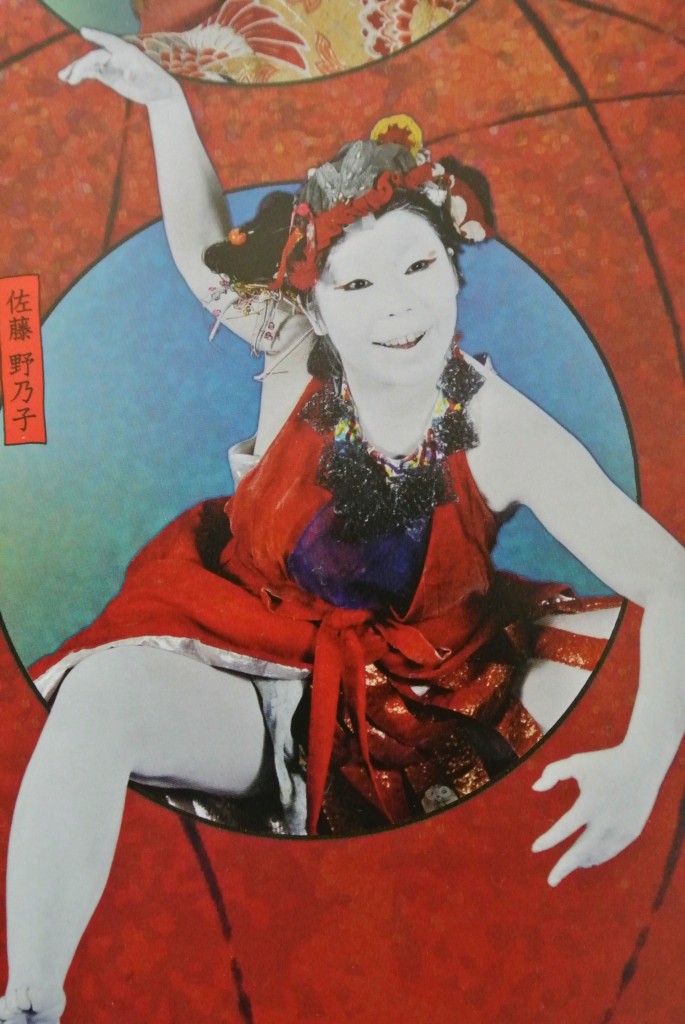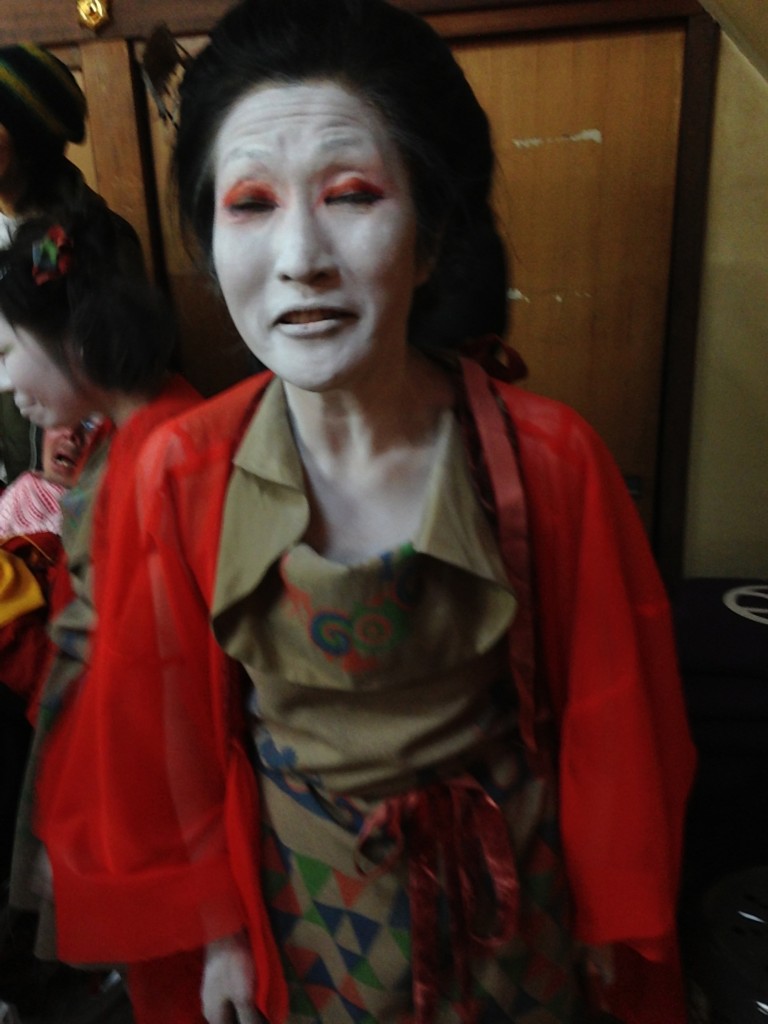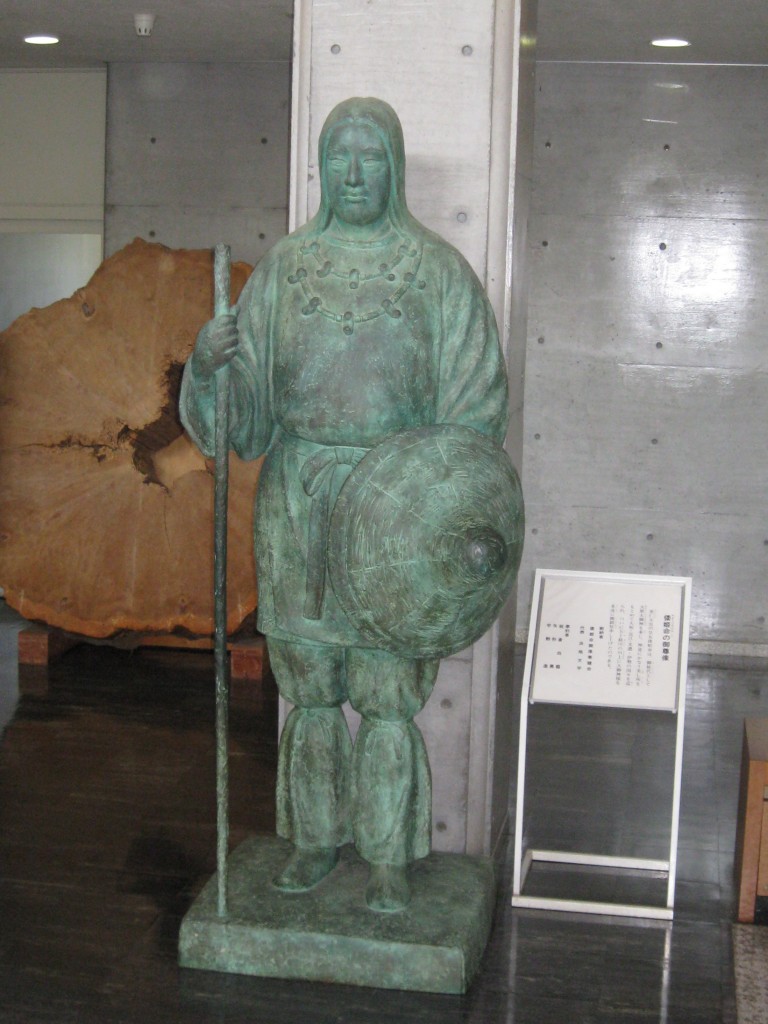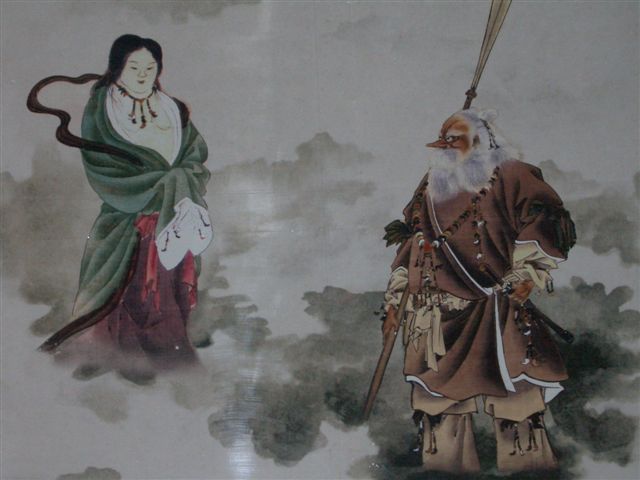
A butoh performance of female sexuality re-emerging from the Rock Cave
Last night in Kyoto I attended a striking butoh performance entitled ‘Uzume’. It portrayed the Kojiki deity in the distinctive manner of butoh, which meant that rather than simple narrative there was a succession of scenes in which the writhing and twisted movements suggested the inner nature of the journey. In the jolts and unnatural positioning was the suggestion of spirit possession. There was a strong primal atmosphere about the performance that spoke to the earliest stirrings of (wo)mankind.

Ame no Uzume in butoh garb and appearance
Uzume is an intriguing character because of her role in Japan’s primal myth, The Heavenly Rock-Cave (Ama no Iwato). She’s often neglected by traditionalists, because in her dance performance which draws the sun goddess Amaterasu out of her cave she exposes her breasts and private parts. These symbols of vitality and fertility are enough to repel the forces of darkness and reawaken life in the universe.
In neglecting the sexuality of Uzume, puritans and prudes have sought to make Shinto ‘safe’ and ‘respectable’. They are the same people that covered up the phalli and vulvae that used to be a common sight around Japan. They thought sexuality was shameful for an imperial state religion, and Shinto as a fertility religion was repackaged as Shinto as a nature religion. Ancestors not fertility rites are still given emphasis in public.
Much of the blame for this can of course be put on Western attitudes which were imported after the opening up of Japan in the 1850s. Christianity in particular preached that there was something shameful about the human body and that sex should be hidden away. As Alan Watts pointed out, no other religious culture in the history of mankind has been so obsessed with the subject.
Now as we move into a post-Christian age, things are changing and human sexuality is once again being liberated and celebrated. The Uzume on stage last night danced the central scene completely naked save for a minimal loin cloth barely covering the area between the legs. In a sense this was a feminist reclaiming of the body, and the production was notable for having four female dancers represent the festival of gods which takes place outside the Rock-Cave. Uzume was here presented as the physical vessel into which the lifeforce enters, the living key to the opening of the cave. Here, triumphantly, was the bringer of joy and sunshine.
*****************************************************
Wikipedia on Uzume…
Ame-no-Uzume-no-mikoto (天宇受売命) is the goddess of dawn, mirth and revelry in the Shinto religion of Japan, and the wife of fellow-god Sarutahiko Ōkami. She famously relates to the tale of the missing sun deity, Amaterasu Omikami. Her name can also be pronounced as Ama-no-Uzume.

A respectable Uzume at the Ise Jingu musuem
Amaterasu’s brother, the storm god Susano’o, had vandalized her rice fields, threw a flayed horse at her loom, and brutally killed one of her maidens due to a quarrel between them. In turn, Amaterasu became furious with him and retreated into the Heavenly Rock Cave, Amano-Iwato. The world, without the illumination of the sun, became dark and the gods could not lure Amaterasu out of her hiding place.
The clever Uzume overturned a tub near the cave entrance and began a dance on it, tearing off her clothing in front of the other deities. They considered this so comical that they laughed heartily at the sight.[3] This dance is said to have founded the Japanese ritual dance, Kagura.
Amaterasu heard them, and peered out to see what all the fuss was about. When she opened the cave, she saw her glorious reflection in a mirror which Uzume had placed on a tree, and slowly emerged from her hiding spot.
At that moment, the god Ame-no-Tajikarawo-no-mikoto dashed forth and closed the cave behind her, refusing to budge so that she could no longer retreat. Another god tied a magic shimenawa across the entrance. The deities Ame-no-Koyane-no-mikoto and Ame-no-Futodama-no-mikoto then asked Amaterasu to rejoin the divine. She agreed, and light was restored to the earth.
Ame-no-Uzume-no-Mikoto is still worshiped today as a Shinto kami, spirits indigenous to Japan. She is also known as Ame-no-Uzume-no-Mikoto, The Great Persuader, and The Heavenly Alarming Female. She is depicted in kyōgen farce as Okame, a woman who revels in her sensuality.
**************************************************
For an account of a fertility rite, see here. For a shrine with fertility symbols, click here. For fertility festivals near Nagoya, including Honen Festival, click here or here.

The meeting of a fecund Uzume and a phallic Sarutahiko as depicted on an ema at Tsubaki Jinja

Fascinating. I’ve always thought of Butoh as pretty heavy stuff. Not at all the kind of dance I would have associated with the joyful Ame-no-Uzume. Then again, the photo you share at the top may be the happiest looking Butoh dancer I’ve ever seen! Despite the Butoh trappings, did you feel like the dance somehow expressed mirth and revelry?
I certainly know what you mean by ‘heavy stuff’ as some butoh certainly can appear so, but I’ve also seen very light-hearted butoh performances with a good dose of humour. In this case there were pieces that full of contortions that looked more tortured than mirthful, and I took them to refer to the forces of darkness unleashed by Amaterasu’s retreat within the cave. However, when it came to the festivity, and particularly to the opening of the cave, there was a definite suggestion of liberation and mirth.
“…a definite suggestion of liberation and mirth.” Carefully chosen words! :-)
Despite my slight suspicion of a butoh concept of mirth, clearly every style of performance has different strengths to offer in a re-telling. And I believe that any art which reenacts mythological patterns has a special kind of power. I wish I could have been there!